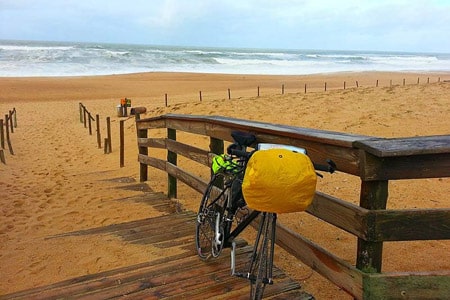At the gateway to Bayonne, between the Landes and Basque regions, Tarnos is the southernmost of the Landes resorts, located at the mouth of the Adour river. From the coastal dunes to the Barthes du Seignanx, Tarnos boasts a singular natural and landscape heritage, to which are added the vestiges of a particularly rich industrial past. What to see and do in Tarnos? Follow the guide!

The beaches of Tarnos
Nestling at the mouth of the River Adour, Tarnos is home to five kilometers of beach protected by the coastal dunes of Aquitaine. Considered one of the
most beautiful beaches in the southern Landes
the Métro beach is the most famous, little frequented and very wild, offering a view of the Basque mountains in the distance. From the beach, the dune promenade leads to an observatory overlooking the Pyrenees mountain range.
La Digue beach (Plage Nord) is also well worth a visit. Built in the 1960s to protect the entrance to the port of Bayonne from swell, the Grande Digue de Tarnos offers a unique view of the Landes and Basque coasts. A stroll along the kilometer-long jetty along the beach is a must in Tarnos.
Castillon park, lake and castle
The city’s green lung, Parc de Castillon offers walkers a pleasant, bucolic setting in the heart of a 22-hectare estate whose origins date back to the 18th century. There’s a fishing lake where dozens of ducks frolic, a large wooded park for picnics and the ghostly ruins of an ancient castle.
Cycle routes and cycle paths around Tarnos
In Tarnos, the La Vélodyssée cycle path follows the coastline and passes through some of the most famous seaside resorts on the Basque-Landes coast, alternating between urban passages and forest tracks. A short bike ride of around 8 km allows families and beginner cyclists to reach Ondres via the Métro forest. On the way down to the Basque coast, the cycle path also takes you to Bayonne (10 km) or Anglet (20 km).
For more experienced cyclists, a beautiful 45 km bike loop takes enthusiasts all the way to
Hossegor
passing through Ondres, Labenne and
Capbreton
. Allow half a day, or even a day, if you take the time to do a little sightseeing.
Les Barthes de l’Adour
Make the most of your stay camping in Tarnos to discover the marshy meadows of the Adour river on a hike along the Barthes greenway towards Saint-Laurent-de-Gosse. Classified as a Natura 2000 site, the Barthes de l’Adour are alluvial and marshy lands reclaimed in the late 17th century by Dutch engineers. Today, this natural site, unique in France, is a precious ecological heritage, notably for its remarkable flora and fauna and its typical architectural heritage.
La Cité des Forges, a city within a city
At the end of the 19th century, the Adour Estuary was home to a vast iron and steel complex, which led to the creation of a workers’ village in Tarnos: Cité des Forges. Listed as a Zone de Protection du Patrimoine Architectural, Urbain et Paysager (ZPPAUP – Architectural, Urban and Landscape Heritage Protection Zone) in 2006, the Notre Dame des Forges church, the school, the foremen’s blocks and the “barracks” (workers’ housing) still bear witness to this industrial past, which is rather rare in the Landes region.
The massif des forges de l’Adour trail
More than 20% of Tarnos is forested. Starting from the “Chemin des Allemands”, a 2-kilometre interpretation trail allows walkers to discover the dune and the coastal forest in a fun and educational way. At each of the thirteen stations along the route, you’ll learn a little more about the formation of the dune belt, the evolution of the landscape and the flora and fauna.
photo@Gilles Guillamot, CC BY-SA 3.0, wikimedia
